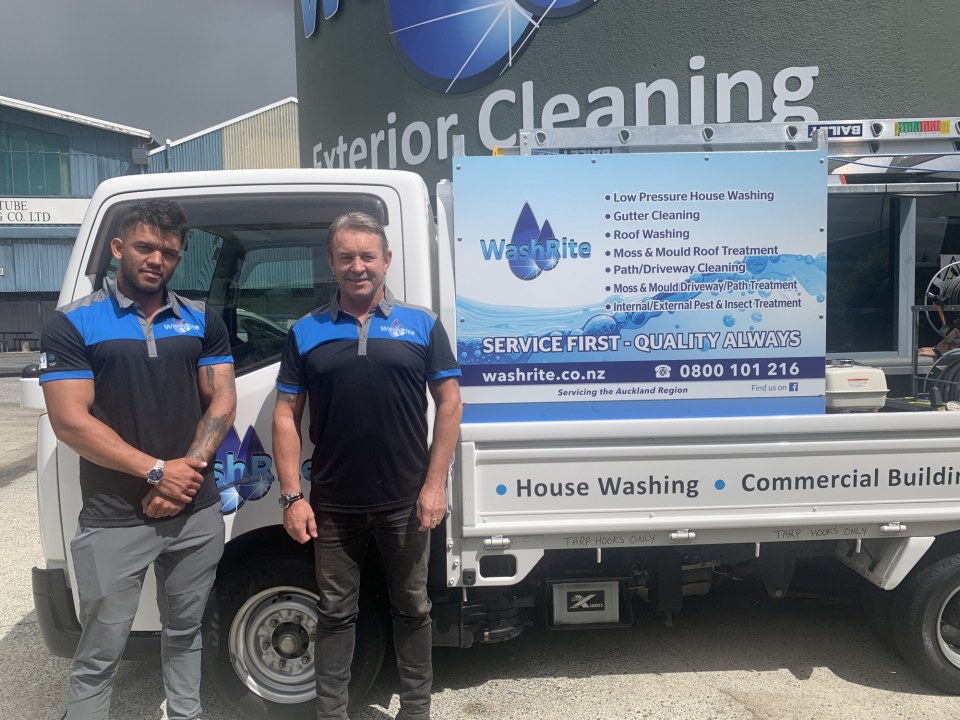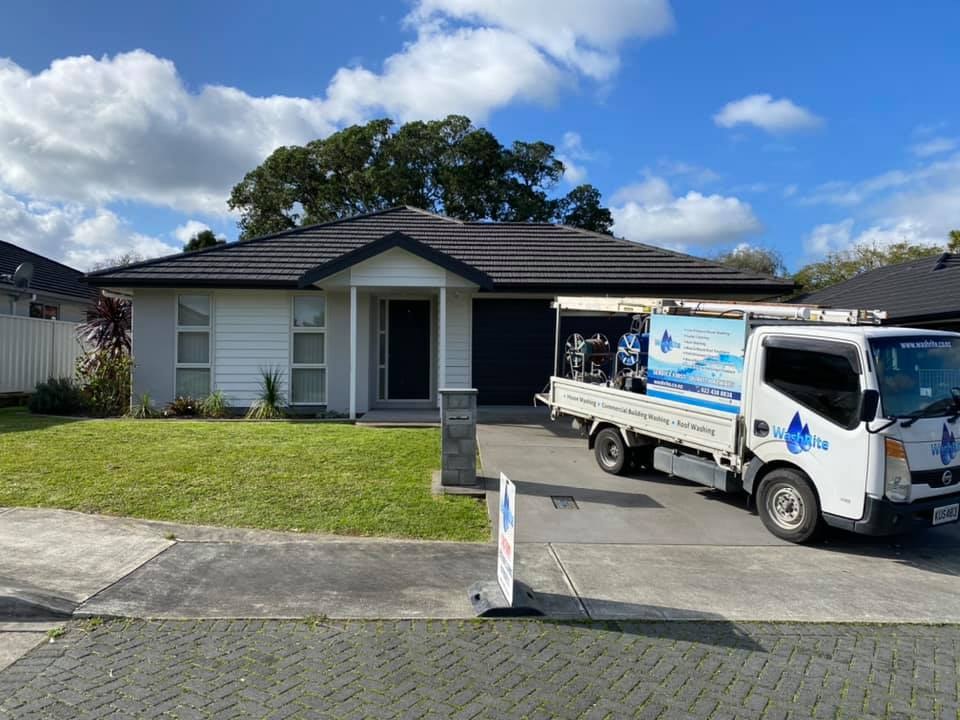After washing thousands of houses around the Auckland area, we thought it might be handy to put up a house washing guide that highlights a few of the things we know to help those washing their house themselves or just for those to see how we like to go about our house washing work.
All house washing work, no matter the style of house, is largely similar. House washing is the process of removing all foreign material from the house. This house wash guide will walk you through the process and give tips and techniques to ensure a great house wash and maximum efficiency.
Why Washing Your House is Important
Washing your house isn’t just about making it look pretty. It’s about making it safe. Without regular exterior house washing, you run a high risk of incurring permanent damage such as rot, stain, mould growth, and more. A good property wash is also an excellent way to stop spiders, earwigs, and centipedes from getting too cosy.
The Dangers of Not Washing Your House
After rain or fog, moisture can cling to your house and cause damages or imperfections that are tough to get rid of. When mould forms, it can eat away at painted surfaces, destroying both their appearance and the weather protection the paint provides. Small cracks and crevices, such as the edges of your windows and doorways, are especially prone to accumulating mould, algae, moss, and dirt. These things can also attract unwanted pests such as animals and insects.
Ways to Wash Your House
There are two main methods for washing your house: Soft washing and pressure washing.
Soft Washing
Soft washing uses low pressure and is a lot safer in terms of preventing damage to your house. For most situations, a soft wash is the way to go. Concrete that is under three years old should always be soft washed to ensure its structural integrity is not compromised. Special cleansers can help destroy unwanted materials such as moss. Unless you’re dealing with particularly difficult stains or residual material, we recommend you choose soft washing as your standard method of exterior care.
Pressure Washing
Pressure washing uses water under high pressure. This method is much more effective at removing stubborn stains, loose paint, and other heavily embedded contaminants. However, high-pressure water blasting can easily destroy fragile materials such as weak timber, loose shingles, and even thin glass. It is not recommended in most circumstances.
Although pressure washing runs the risk of damaging old or delicate surfaces, it does offer the best solution for removing tougher substances. It is also great at preparing wood or aluminium siding for painting. When it comes to pressure washing your house, your safest bet is to leave it to the professionals.
Exterior House Washing: Step by Step
Now that you understand why washing your house is important and the different methods for doing it, let’s dive into the steps. In this article, we will only be looking at the soft washing method.
What You’ll Need to Wash Your House
The essentials for washing your house are as follows:
Soaps, or other desired cleaning product.
A pump sprayer.
A ladder (depending on the height of your house).
A power washer.
Safety goggles.
Rubber gloves.
Sun protection.
Old clothes for working in.
A warm, dry day (ideal for identifying stains and blemishes).
A mat or tarp to cover nearby plants and belongings.
Once you’ve acquired all of the above, you’re ready to start washing your house.
NB: Please bear in mind, these steps are for low-pressure house washing. We recommend high-pressure washing only when absolutely necessary.
Step 1) Prepare the Environment
Lay your mat or tarp over any items, including plants, that you don’t wish to get dirty. Exterior house washing can be a very messy job, so it’s essential that you protect everything before getting started.
You should also inform any members of your house or neighbours living in close proximity that you will be performing an exterior cleaning wash. If there’s a risk of debris hitting a neighbour’s car or property, make sure you take steps to mitigate the risk before it happens.
Step 2) Prepare Your Soap Mixture
Whether you’re using bleach, a special cleaner, soap, or a combination of each (diluted with water, of course), your first step will be to get it ready. Follow the instructions on the back of the bottle if using a store-bought cleaning agent when diluting your mixture.
If using bleach, a good rule of thumb is to dilute it to 1% bleach, 99% water. When finished mixing, fill the pump sprayer with your chosen mixture. If you decide to go with any mixture that isn’t simply soap and water, be sure to wash your hands thoroughly after preparation and keep any chemicals well away from your eyes.
Step 3) Spray, Wash, Repeat
Working in sections of 3–5 square meters at a time, begin by coating an area of the wall with your cleaning mixture. Start from the bottom and move upwards, avoiding any windows where possible. Allow a few minutes for the mixture to do its work, then rinse the walls with your pressure washer. Repeat this process for the entire house.
Step 4) Check for Any Missed Spots
If you have a large house with lots of walls, there’s a good chance you will have missed a few spots. Do a quick once-over of the entire property, attacking any remaining stains or grime with the soft washer. When you’re finished, dispose of the chemicals safely and wash your hands thoroughly. Be sure to throw any clothes that may have been in contact with chemicals straight into the wash.
Step 5) Enjoy Your Clean House
Congratulations, you’ve now got a sparkly new exterior for your home! Remember that house maintenance needs to be a regular thing. The longer you leave it, the greater the risk of irreversible damage in the future.
Standard House Wash
A standard house wash consists of:
Removing all cobwebs.
Cleaning the outside edge of guttering, eaves, barge boards, gable ends, flashings, all cladding, outside of windows, doors, and exterior framework and paintwork.
Basic House Washing Technique
Use a low-pressure chemical nozzle to apply soft house wash solution to one wall of the house (apply from the bottom of the house up to avoid streaks). Make sure every inch of surface is wet with chemicals and allow it to soak into the dirt and grime for between 1 and 3 minutes so that it’s easier to wash off. Then, using your white nozzle, thoroughly rinse off all foreign matter from the house before the chemical dries up.
Use your brush to loosen up any remaining dirt around door and window frames and rinse again so that you don’t have to use as much pressure when washing around window edges. Repeat the process on the next area.
Time-saving tip: When a home has balconies or porches with balustrades, wash the outside edge of the porch and balustrades first and wash the house last. The dirt that gets squirted from the balustrades towards the house can then be rinsed off the house when it comes to washing the house.
Double Checking
Always double-check your work! After completing a house wash, slowly walk around the house and check every nook and cranny, behind barge boards, under weatherboards, and all sides of window frames. Getting into this simple habit will help you to discover the spots you most commonly miss, and the extra effort doesn’t go unnoticed.
Chemical Washing
A chemical mix combining sodium hypochlorite, water, and citrus wash is the most effective for removing grime, mould, and dirt from a house with the least amount of effort. The sodium hypochlorite dissolves most forms of light mould and dirt, and the citrus wash helps to lower the surface tension of the water so it can further penetrate grime more easily than sodium hypochlorite alone. The citrus wash also helps when rinsing windows to leave them streak-free.
Note: The citrus wash creates bubbles/foam and helps to make it more evident when the house washing solution has reached your gun through the hose from the venturi.
Light Mix
For houses that are not overly dirty or have delicate plants and vegetables in close proximity to the house, it pays to use a weaker mix of the sodium hypochlorite to carry out a house wash.
Method: In a 20L container add between 500ml and 1L of pool-grade sodium hypochlorite. Then fill the container almost to the top with water and top up with between 250ml and 500ml of citrus wash or sugar soap.
Medium Mix
For more prevalent mould and grime.
Method: In a 20L container, add between 2L and 6L of sodium hypochlorite. Then fill the container almost to the top with water and top up with between 250ml and 500ml of your favourite degreaser or surfactant soap.
Full Mix
Warning: For red mould only.
Method: Feed the venturi hose directly into your container of sodium hypochlorite. Apply the chemical to red mould and scrub in. May require 2 or more applications and rinsing and/or blasting.
Note: Use a chemical grade mask and avoid coming into contact with the solution at full strength.
Pro Tip: For best results, spray the dry surface with the solution. Do NOT wet the area first.
Note:These mix rates are as a guide only. See Material Safety Data Sheets (MSDS) for further information.
Hose Management (for long high pressure hose)
Hose management is particularly important on house washing jobs. Give thought to any delicate plant life and be aware that pulling hose through gardens, around the corners of a house, or around things like fences, can cause damage. Each time you move around the corner of a house with the gun, gather the hose by pulling the hose from the water blasting unit towards you at the corner. Then you can walk forward with the gun without having the resistance of pulling the hose around a corner. Repeat the process as you move back around the house.
Note: Pot plants are a hose's worst enemy; move them away from work areas to avoid damage.
Note: Grabbing the hose in a bunch and dragging it back around the house together will more than likely leave you with a tangled hose and will create an extra job, wasting your time.
Here is a great article about damage from incorrect house washing techniques and how to avoid them.
Hose vs. Balcony Handrails
If you have to wash a house from up on a balcony or porch, take the gun and hose through the balustrades, not over the top of the handrail. You’ll be less likely to leave damage and marks.
Ingress Control
Controlling the ingress of water into a house should be a top priority when washing any building.
Prevention
Close and tightly latch windows; this will help to stop water and chemical sprays from entering the house while washing.
Application Technique
Apply chemicals to windows and doors at low pressure. Keep the tip of the nozzle more than a meter from the surface of the house and move the water blasting gun in a swift, horizontal sweeping motion while spraying. It helps to keep the spray from the nozzle in a vertical line across the house, which minimizes ingress through the tops of window frames and any gaps in weatherboards (the most susceptible areas).
Identifying Compromised Integrity
As you are washing a house, identify problem areas, e.g., gaps in window frames, weatherboards, cladding, and gaps under doors. Use your telescopic brush to scrub these areas before rinsing off chemicals. This will allow you to rinse dirt off using less water and less pressure, minimizing ingress into the house while washing.
Rinsing Technique
Rinse off dirt from around window and door frames by spraying water at an acute angle sideways across the building; less than 45° is optimal for dramatically reducing ingress. Keeping your distance while rinsing off will help to minimize ingress into the house also.
Pro Tip: Take your time with rinsing off walls and windows. It should take around three times longer than applying the chemical to achieve the best results.
Pro Tip: Keep a roll of duct tape to tape up large gaps at the base of doors or where the ground falls towards a door, or if clients are particularly concerned about any water ingress. Use good quality duct tape to minimize the risk of pulling off old or flaking paint.
Heights Avoidance
One of the best ways to speed up your work and stay safe is by enabling yourself to stay on the ground and complete work satisfactorily from there. This saves you from having to handle ladders around properties and climbing to get close to your work.
Correct Chemical Mix
Ensure you’re using a strong enough mix of chemicals. The correct mix should work effectively on stains out of your reach, and you will avoid having to get close to them to blast them off.
Chemical Delivery
Getting your chemical to a height can be done by using a longer wand or spraying the chemical up high using a red 0° jet nozzle.
Pro Tip: Fill your hose with chemical using the black nozzle, swap to the red nozzle, and shoot the chemical up to the area you need to wash. Let the chemical soak in over the course of a minute or two, then rinse using the red nozzle once water reaches the lance again.
Extension Gear
The right extension brush can reach high to scrub stubborn stains and lichen from the ground.
Pre-Paint Washing
Depending on the painter’s requirements, they will generally request a thorough chemical wash combined with water blasting to remove flakey paint. A chemical wash should always be highly recommended as it kills any organic matter attached to house surfaces.
Note: Painters' biggest gripe is with dirt still being left on the underside of the bottom three or four weatherboards. It’s easy to forget these areas as they’re not visible when standing looking down. Form the habit of aiming your gun up under these lower boards to apply chemicals and rinse off with water.
Window Cleaning
As a part of your house wash, it’s nice to include exterior windows. It doesn’t take a lot of effort to get streak-free results.
Window Cleaning Method
Once the chemical has been applied to the house and windows, give the windows a quick scrub with your soft house wash brush. When it comes to rinsing off the chemical from the house, leave the windows until absolute last after all the chemical solution and any dirt is removed from the rest of that wall of the house. Next, proceed to rinse the windows with a generous amount of water (see ingress control to avoid leaks inside). Windows should then be double-checked at the end of the job and may require a further rinse.
Maintaining the exterior of your home with regular house washing not only enhances its appearance but also protects it from potential damage. Following these guidelines and tips can help you achieve a thorough and efficient house wash, ensuring your home remains in great condition for years to come. Remember, a clean house is a happy house!
Link: Check our Wash Rite Website  21 Jan 2021
21 Jan 2021 27 Jul 2021
27 Jul 2021 15 Aug 2021
15 Aug 2021





